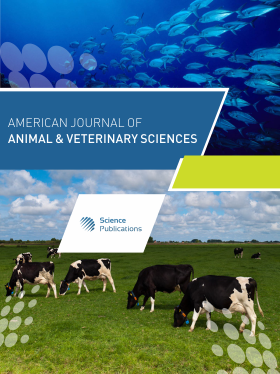Parasitic Loads and Growth Performance of Goats and Kids under Sequential and Mixed Species Grazing with Cattle at a Constant Stocking Rate
- 1 Southern University Agricultural Research and Extension Center, United States
- 2 Southern University and A and M College, United States
Abstract
The objective of this study was to evaluate the effects of sequential and mixed species grazing on parasitic loads and growth performance of goat kids. The study was conducted between June and October, 2013. Forty eight (48) "Spanish" kids and 28 Brangus calves were randomly divided into four treatment groups; goats grazing alone (GOA, control), Goats Followed by Cattle (GFC), Cattle Followed by Goats (CFG) and, cattle and goats mixed (MXD) grazing. Each pasture was sub-divided into 8 grazing paddocks to facilitate intensive grazing. Each of the 8-ha grazing pasture was sub-divided into two replications and eight paddocks. Animals were moved to a new paddock twice a week (3.5d rotation). The initial stocking rate was based approximately upon 0.8 ha per cow that would allow five cows per replication. Body Weights (BW), body condition score (1=thin, 5=fat, BCS), Famacha© scores (1=pink, healthy eye, 5=white, anemic) and fecal and blood samples were taken bi-weekly. Fecal and blood samples were analyzed in the lab for fecal egg count in eggs per gram (FEC) and Packed Cell Volume (PCV) percentages. Data was statistically analyzed using SAS’s MIXED procedure and correlation coefficients were determined among the measurements. Differences (p<0.05) among treatment groups were observed where kids in GOA group were lighter in weight (13.2±0.0 Vs. 17.3±0.6 kg) and less conditioned (1.9±0.07 Vs. 2.3±0.07) than the CFG, GFC and MXD groups combined. No difference in Famacha© scores (2.3±0.07 Vs. 2.3±0.06) and PCV percentages (29.4±0.8 Vs 27.7±0.8) were observed between GFC and MXD groups. Male kids were about 1 kg heavier than female kids. BW was positively (p<0.05) correlated with BCS, HG, PCV and negatively with FEC. BCS was positively (p<0.05) correlated with HG, PCV and negatively with FEC. After the eighth week of the study, kids in GFC and MXD groups had lower Famacha© scores and higher PCV levels than kids in GOA and CFG groups. Overall, compared to kids grazing alone, mixed and sequential grazing kids had higher BCS, BW and PCV levels and lower Famacha© scores.
DOI: https://doi.org/10.3844/ajavsp.2015.141.149

- 5,861 Views
- 4,787 Downloads
- 2 Citations
Download
Keywords
- Growth Performance
- Goats
- Sequential Grazing
- Fecal Egg Count
- Mixed Grazing
